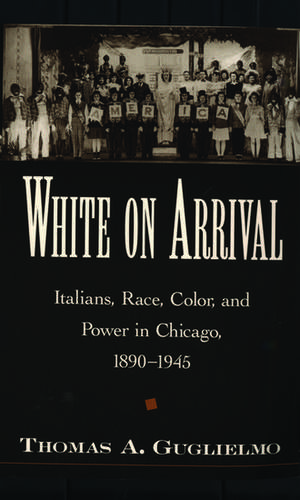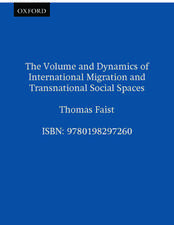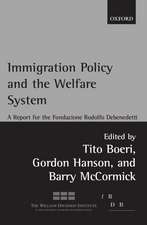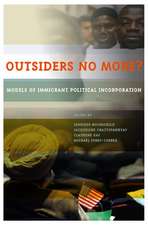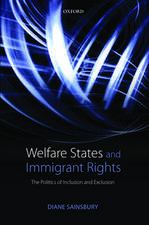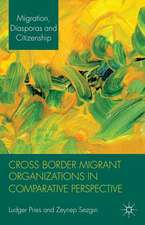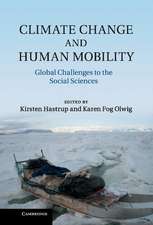White on Arrival: Italians, Race, Color, and Power in Chicago, 1890-1945
Autor Thomas A. Guglielmoen Limba Engleză Paperback – 28 oct 2004
Preț: 280.53 lei
Nou
Puncte Express: 421
Preț estimativ în valută:
53.68€ • 56.05$ • 44.33£
53.68€ • 56.05$ • 44.33£
Carte tipărită la comandă
Livrare economică 04-10 aprilie
Preluare comenzi: 021 569.72.76
Specificații
ISBN-13: 9780195178029
ISBN-10: 0195178025
Pagini: 296
Ilustrații: 5 halftones and 5 line drawings
Dimensiuni: 156 x 233 x 20 mm
Greutate: 0.42 kg
Ediția:Oxf Univ PR Pbk.
Editura: Oxford University Press
Colecția OUP USA
Locul publicării:New York, United States
ISBN-10: 0195178025
Pagini: 296
Ilustrații: 5 halftones and 5 line drawings
Dimensiuni: 156 x 233 x 20 mm
Greutate: 0.42 kg
Ediția:Oxf Univ PR Pbk.
Editura: Oxford University Press
Colecția OUP USA
Locul publicării:New York, United States
Recenzii
"an important advance in our understanding of the racila dynamics involving early twentieth-century immigrants. A major contribution that deserves to exercise a major influence on the discussion of race in the US."-- American Historical Review
"White on Arrival gets here right on time. As we increasingly require histories that speak to the ways race has been made both in the U.S. and beyond its borders, Guglielmo provides a meticulous local study aware of the international flows of migrants and ideas. As we urgently need mature historical accounts providing the historical context for debates over affirmative action and reparations, he carefully and compellingly shows how Italian Americans both felt the brutalities of race and benefitted from the privileges of whiteness."--David Roediger, University of Illinois
"How did the 'New Immigrants' of the early twentieth century become the 'White Ethnics' of the postwar era? In this exhaustively researched study of one immigrant group's encounter with race, Tom Guglielmo provides an unusual perspective on the everyday bases of racial identity, thinking, and behavior. He roots his discussion in the everyday lives of Italian immigrants and their neighbors and in the process illuminates the complex process by which Italians became 'Americans' in the racially-charged atmosphere of early twentieth century Chicago's politics, labor relations, popular culture, and residential life. An outstanding social history, White on Arrival also speaks to cultural and intellectual historians concerned with the idea of race and its implications for the cultural lives of common Americans."--James R. Barrett, University of Illinois at Urbana-Champaign
"Every time I think the 'whiteness studies' paradigm has crashed and burned, another careful innovative, illuminating study comes along to prove me wrong. Thomas Guglielmo's White on Arrival is just such a study. It is a deeply researched, richly textured treatment of both sides of a complicated equation: the ways in which it mattered that 'Italianness' was conceived in biologized, 'racial' terms, and the ways in which it mattered (and continues to matter) that Italian immigrants and their American-born children nonetheless shared a safe haven of legal whiteness with a number of other 'white' groups on the scene."--Matthew Frye Jacobson, Yale University
"In this original, provocative, and theoretically sophisticated study, Thomas Guglielmo offers us the first substantive, in-depth examination of Italian immigrants, racial categorization, and racial identity in early 20th century America. Grounding his arguments and findings in extensive primary research, he successfully refutes many of the premises and conclusions advanced by the 'whiteness school,' providing an alternative and often compelling narrative and methodology for exploring the history of immigration and race."--Eric Arnesen, University of Illinois at Chicago
"During the 1990s, a variety of studies adopted the notion of south, central, and eastern European immigrants as 'in-between people,' who were neither fully black nor white, during their early encounter with industrial America. While such studies illuminated racial formation as a historical process, Professor Guglielmo convincingly argues that such studies often oversimplified the phenomenon. Based upon a broad range of archival sources and oral interviews with Italians in Chicago, Professor Guglielmo carefully documents the white skin privileges that Italians enjoyed from the outset of their sojourn on American soil."--Joe W. Trotter, Carnegie Mellon University
"A sophisticated and subtle analysis of how two very different notions of race, one grounded in perceptions of color and the other in nationality, shaped the experience of Italians in pre-World War II Chicago. Thomas Guglielmo's book marks an important advance in whiteness and immigration scholarship and demonstrates, once again, the value of community studies to our understanding of modern America."--Gary Gerstle, author of American Crucible: Race and Nation in the Twentieth Century
Guglielmo's investigation of racial dynamics in early 20th Century Chicago is a meticulous local study within the framework of the flow of migrants and ideas providing an historical context for the discussion of affirmative action and reparations.
"White on Arrival gets here right on time. As we increasingly require histories that speak to the ways race has been made both in the U.S. and beyond its borders, Guglielmo provides a meticulous local study aware of the international flows of migrants and ideas. As we urgently need mature historical accounts providing the historical context for debates over affirmative action and reparations, he carefully and compellingly shows how Italian Americans both felt the brutalities of race and benefitted from the privileges of whiteness."--David Roediger, University of Illinois
"How did the 'New Immigrants' of the early twentieth century become the 'White Ethnics' of the postwar era? In this exhaustively researched study of one immigrant group's encounter with race, Tom Guglielmo provides an unusual perspective on the everyday bases of racial identity, thinking, and behavior. He roots his discussion in the everyday lives of Italian immigrants and their neighbors and in the process illuminates the complex process by which Italians became 'Americans' in the racially-charged atmosphere of early twentieth century Chicago's politics, labor relations, popular culture, and residential life. An outstanding social history, White on Arrival also speaks to cultural and intellectual historians concerned with the idea of race and its implications for the cultural lives of common Americans."--James R. Barrett, University of Illinois at Urbana-Champaign
"Every time I think the 'whiteness studies' paradigm has crashed and burned, another careful innovative, illuminating study comes along to prove me wrong. Thomas Guglielmo's White on Arrival is just such a study. It is a deeply researched, richly textured treatment of both sides of a complicated equation: the ways in which it mattered that 'Italianness' was conceived in biologized, 'racial' terms, and the ways in which it mattered (and continues to matter) that Italian immigrants and their American-born children nonetheless shared a safe haven of legal whiteness with a number of other 'white' groups on the scene."--Matthew Frye Jacobson, Yale University
"In this original, provocative, and theoretically sophisticated study, Thomas Guglielmo offers us the first substantive, in-depth examination of Italian immigrants, racial categorization, and racial identity in early 20th century America. Grounding his arguments and findings in extensive primary research, he successfully refutes many of the premises and conclusions advanced by the 'whiteness school,' providing an alternative and often compelling narrative and methodology for exploring the history of immigration and race."--Eric Arnesen, University of Illinois at Chicago
"During the 1990s, a variety of studies adopted the notion of south, central, and eastern European immigrants as 'in-between people,' who were neither fully black nor white, during their early encounter with industrial America. While such studies illuminated racial formation as a historical process, Professor Guglielmo convincingly argues that such studies often oversimplified the phenomenon. Based upon a broad range of archival sources and oral interviews with Italians in Chicago, Professor Guglielmo carefully documents the white skin privileges that Italians enjoyed from the outset of their sojourn on American soil."--Joe W. Trotter, Carnegie Mellon University
"A sophisticated and subtle analysis of how two very different notions of race, one grounded in perceptions of color and the other in nationality, shaped the experience of Italians in pre-World War II Chicago. Thomas Guglielmo's book marks an important advance in whiteness and immigration scholarship and demonstrates, once again, the value of community studies to our understanding of modern America."--Gary Gerstle, author of American Crucible: Race and Nation in the Twentieth Century
Guglielmo's investigation of racial dynamics in early 20th Century Chicago is a meticulous local study within the framework of the flow of migrants and ideas providing an historical context for the discussion of affirmative action and reparations.
Notă biografică
Thomas A. Guglielmo is an Assistant Professor of American Studies at the University of Notre Dame.
